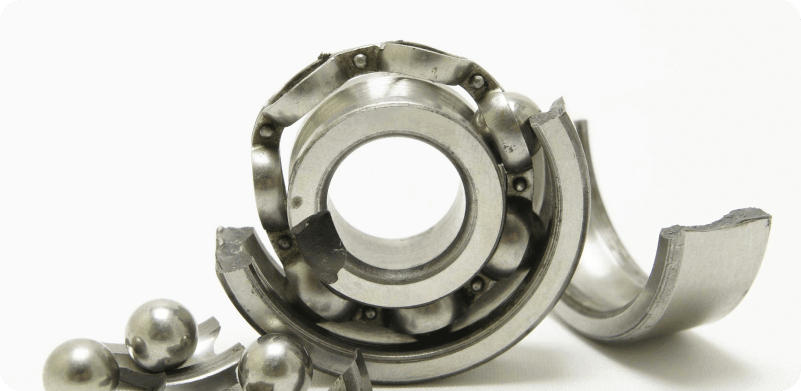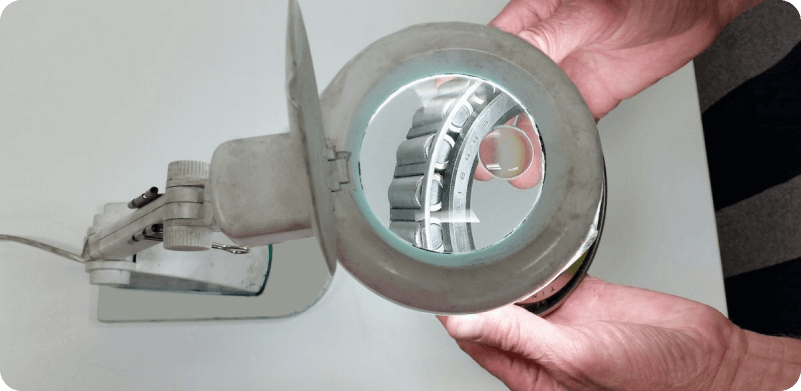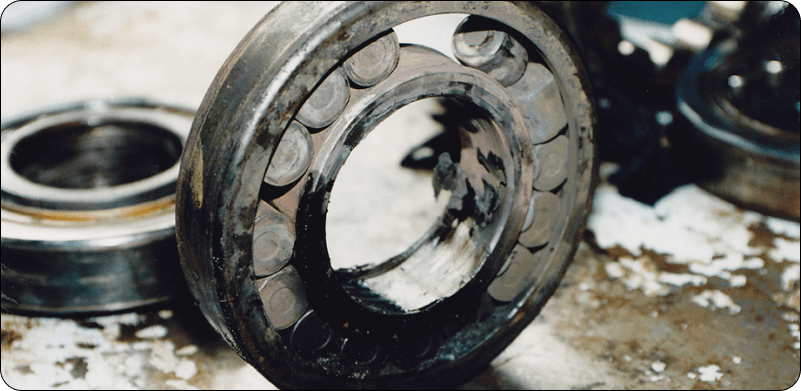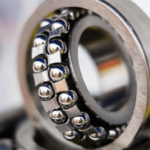Bearings and bushings play a crucial role in the smooth functioning of various machines and equipment, from automobiles to industrial machinery.
Bearings allow for the rotational or linear movement of machinery parts, reducing friction and wear and tear. However, bearings are subject to failure due to various factors, causing severe damage to the equipment and even posing safety risks.
In this blog, we will discuss the common reasons for bearing failure, the stages of damage, and preventative measures to ensure efficient and safe machinery operation.
Causes of Bearing Failure
Lubrication Failure
The first thing to check after a bearing and bushing failure is your lubrication. Improper lubrication is at the root of 43% of mechanical failures, 70% of equipment failures, and 50% of roller bearing damage. However, bearing failures occur because of many different lubrication issues, not simply under-lubrication. Your problem may be:
Under Lubrication: This leads to metal-on-metal contact and increased wear. When there is not enough lubrication to separate the rolling elements from the raceways, the friction between them increases, causing excessive heat, and ultimately leading to bearing failure.
Over Lubrication: This increases friction, causing temperatures to rise. Over-lubrication can lead to churning and aeration, which can also damage the bearing and decrease its lifespan.
Inadequate Viscosity at Operating Temperatures: Using a lubricant with inadequate viscosity at operating temperatures can lead to insufficient oil film and the potential for metal-on-metal contact, causing bearing failure.
Using the Wrong or Incompatible Lubricants: Different types of bearings require different types of lubricants. Using the wrong lubricant or a lubricant that is incompatible with your bearings can cause a reaction that accelerates your bearing wear rate.
Leaking Seal: A leaking seal allows lubrication to escape, leaving your machine under-lubricated. This can cause the bearing to overheat and fail prematurely.
To prevent lubrication failure, it is essential to follow the manufacturer’s recommended lubrication intervals and use the correct type and amount of lubricant. Regular inspections of the lubrication system, seals, and oil levels can help identify and prevent lubrication-related issues.
Contamination
Contamination is another leading cause of bearing and bushing failure. Even small particles, such as dust, dirt, and moisture, can damage bearings over time. Contamination can enter the bearing through various sources, including the lubrication system, the surrounding environment, or during installation and maintenance.
When contaminants enter the bearing, they can lead to abrasive wear, corrosion, and pitting, causing premature failure. Contamination can also decrease the effectiveness of the lubricant, leading to metal-to-metal contact and increased friction.
To prevent contamination, it is crucial to keep the surrounding area clean and free of debris. Use proper handling and storage techniques to avoid introducing contaminants during installation and maintenance. Also, consider using seals and shields to protect the bearing from the environment.
Fatigue Failure

Fatigue failure is a common type of bearing failure caused by repeated stress over time. The repeated stress causes micro-cracks to form in the bearing material, which can eventually lead to complete failure. Fatigue failure is often characterized by spalling or flaking on the bearing surface.
To prevent fatigue failure, it is crucial to use bearings with the appropriate load and speed ratings for your application. Regular inspections and maintenance can also help identify signs of fatigue failure early, allowing for timely repairs or replacements.
Misalignment
Misalignment occurs when the bearing is not correctly aligned with the shaft or housing. Misalignment causes increased stress on the bearing, leading to premature wear and failure. Misalignment can be caused by various factors, including improper installation, damaged shafts or housings, and thermal expansion.
To prevent misalignment, it is crucial to ensure proper installation and alignment of the bearing. Check for any damage or wear to the shaft or housing, and consider using alignment tools during installation.
Inadequate Mounting and Fitting
As you delve further into this list of reasons for bearing failure, you may observe a recurring pattern of consequences. Incorrectly installed bearings produce a snug fit that diminishes clearance, raises friction, raises temperatures, and contributes to more wear and tear, leading to bearing failure. As usual, increased temperatures have an impact on the lubricant’s viscosity, exacerbating the issue. You can prevent poor mounting and bearing fit by ensuring that all of your technicians receive proper training on mounting instructions and using appropriate materials.
Excessive Heat
There are many factors on this list that can cause an increase in operating temperatures. However, overheating is worth noting separately because of its significant impact. Elevated temperatures reduce the efficiency of your lubricant, promote oxidation, and decrease the hardness of metal bearings. This can cause your bearings to seize, deform, and eventually fail. The most effective preventive measure is to monitor operating temperatures and implement overload controls, heat paths, or additional cooling.
Installation Errors
Improper installation can also lead to bearing failure. Common installation errors include using incorrect tools or techniques, inadequate lubrication, or improper alignment. These errors can cause damage to the bearing, leading to premature failure.
To prevent installation errors, it is crucial to follow the manufacturer’s installation instructions carefully. Use the recommended tools and techniques, and ensure that the bearing is correctly aligned, lubricated, and protected from contamination during installation.
Bearing Failure Analysis
Bearing failure can occur in different stages, and identifying the stage can help determine the cause of failure and take preventative measures. The four stages of bearing damage are:
Initial stage: In this stage, the bearing shows signs of wear and tear, such as discoloration, flaking, or small cracks. The damage may not affect the bearing’s function, but it’s an indication that something is wrong.
Advanced wear stage: In this stage, the bearing shows significant damage, such as deep grooves, fractures, or broken parts. The bearing may be inoperable or function poorly.
Catastrophic failure: In this stage, the bearing fails completely, resulting in sudden machine failure and potentially dangerous situations.
Preventative Measures:
To avoid bearing failure, you can take the following preventative measures:
Proper lubrication: Use the right type and amount of lubricant and ensure a continuous supply. Regularly check the lubrication system for contamination, leaks, or blockages.
Clean environment: Keep the machine and bearing area clean and free of debris. Use protective covers or seals to prevent contamination.
Load management: Avoid overloading the bearing and ensure even load distribution. Monitor the load regularly and adjust as necessary.
Proper installation: Follow the manufacturer’s guidelines for installation, alignment, and clearance. Use the correct tools and equipment and ensure proper tightening.
Regular inspection: Regularly inspect the bearings for signs of wear, damage, or unusual noise. Replace worn or damaged bearings promptly.

Why Hi-bond Bearings Pvt. Ltd
Hi-bond Bearings Pvt. Ltd. (ISO 9001-2008 certified company) is a leading bearing manufacturer and supplier of high-quality bearings and bushings for the mechanical engineering and manufacturing industries.
We offer a wide range of plain shaft engine bearings and bushings, including thin-walled and thick-walled bi-metal and tri-metal bearings, bushings, and thrust washers.
Hi-bond has established itself as a reputable and reliable company, producing consistently high-quality products with on-time delivery, affordable pricing, and a robust sales network.
We are internationally recognized in over 30 countries, including the UK, Europe, North and South America, the Middle-east, Far-east, Asia Pacific and Russia.
Contact us to learn more about our bearings and bushes suppliers and our extensive range of products, including flange bearings, journal bearings, and more.




